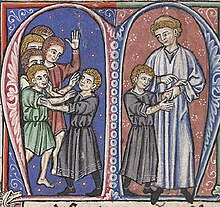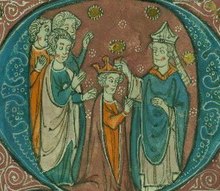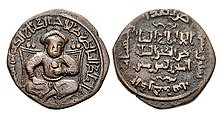Baldwin IV of Jerusalem
| Baldwin IV of Jerusalem | |
|---|---|
Anjou | |
| Father | Amalric of Jerusalem |
| Mother | Agnes of Courtenay |
Baldwin IV of Jerusalem (Latin: Balduinus, French: Baudoin) (1161–1185), known as the Leper King, was the
Baldwin developed the first symptoms of
Childhood
Baldwin was born in mid-1161. His parents were

The Kingdom of Jerusalem and other
As an adolescent, Baldwin was precocious, determined, and optimistic in the face of his illness. He took after his father in good looks, body shape, and manner of walking and expressing himself. Baldwin was a quick learner, but he stuttered. He enjoyed listening to stories and history lessons. His tutor, William, remarked on Baldwin's excellent memory, stating that he forgot neither kindness nor slights done to him by others.[8]
Amalric attempted to have Sibylla marry the French Count
Accession

Upon Amalric's death, the High Court convened to discuss the succession.
After three days of deliberation
Regency

Until he reached the
Baldwin's mother, Agnes, returned to court when Raymond became regent. She is frequently accused by historians of exploiting her son's condition for self-gain, but the contemporary sources, including Baldwin's tutor, William of Tyre, are biased against her.[22] Having grown up without her since the age of two, Baldwin had no memories of his mother, but she became devotedly kind to him and he developed a strong attachment to her.[23]
During the regency it became clear that the King was indeed affected by leprosy.
Personal rule
On the second anniversary of his coronation, 15 July 1176, Baldwin reached the age of majority and Raymond's regency lapsed. At the suggestion of his mother, the King appointed his loyal and capable maternal uncle,
Planned offensive

As soon as he took over the government, Baldwin began planning a full-scale attack on Egypt with his advisers.[33] The King took advantage of Saladin's campaign in Aleppo to lead a raid around Damascus.[31] This was his first experience of warfare. Despite having use of only one hand, he refused to delegate his military duties and took part in fighting.[34] He and his advisers then decided to intervene in Saladin's war against the Order of Assassins. On 1 August, Baldwin and Raymond led the armies of Jerusalem and Tripoli, respectively, in a raid of the Beqaa Valley (modern-day Lebanon), where they defeated the garrison of Damascus, forcing Saladin to abandon his campaign.[35]
William of Montferrat married Baldwin's sister Sibylla, in November 1176 despite misgivings of the nobles who no longer trusted his cousin Emperor Frederick's ability to aid the kingdom. Baldwin offered to abdicate the throne to William according to Sicard of Cremona; if he did, William declined because he knew he lacked the support of the nobility.[36]
In order to carry out his attack on Egypt, Baldwin needed naval support. He thus sent
In April 1177 William of Monferrat fell sick with
The Byzantines sent a war fleet in preparation of the invasion of Egypt
Initial conflicts with Saladin

Philip left the Kingdom of Jerusalem with his troops in late October 1177 to help Raymond of Tripoli attack the Muslim-held city of Hama.[52] With the Frankish army in northern Syria, Saladin seized the opportunity to invade Baldwin's kingdom on 18 November.[53] Though still recovering from malaria, Baldwin rode to meet the sultan,[54] while the Knights Templar hurried to defend Gaza.[53] The King took his humble host to Ascalon, where in desperation he issued an arrière-ban, summoning all able-bodied men. Saladin reached Ascalon on 22 November and Baldwin led the troops out to meet him. Seeing how drastically outnumbered he was, the King retreated into the city. Saladin too saw the strength in his numbers and confidently proceeded towards Jerusalem.[55] Baldwin managed to contact the Templars, however, and ordered them to abandon Gaza and join him.[56] Contrary to the sultan's expectation, Baldwin and Raynald then rode out of Ascalon, joined up with the Templars, and attacked his dispersed army at Montgisard.[57] The young king was in the forefront.[56] Saladin, who barely survived, suffered a crushing defeat.[57]

Not having enough men to launch an offensive on the retreating Muslims, Baldwin decided to fortify the Damascene frontier. The Templars convinced him to build a castle,
In April 1179, Baldwin intended to round up the sheep passing from Damascus to
Rise of factions
In the winter of 1177–78 the King's widowed sister, Sibylla, gave birth to a son,

During the
Baldwin had hoped to abdicate, but was prevented by a deep rift within his court.
To secure Guy's position and prevent the emergence of an alternative claimant, Baldwin had his eight-year-old half-sister, Isabella, solemnly betrothed to the teenaged
| Baldwin IV's family,[74] including the Courtenay party (blue rectangular) and their opponents (red rounded)[69] | ||||||||||||||||||||||||||||||||||||||||||||||||||||||||||||||||||||||||||||||||||||||||||||||||||||||||||||||||||||||||||||||||||||||||||||||||||||||||||||||||||||||||||||||||||||||||||||||||||||||||||||||||||||||||||||||||||||||||||||||||||||||||||||||||||||||||||||||||||||||||||||||||||||||||||||||||||||||||||||||||||||||||||||||||||||||||||||||||||||||||||||||||||||||||||||||||||||||||||||||||||||||||||||||||||||||||||||||||||||||||||||||||||||||||||||||||||||||||||||||||||||||||||||||||||||||||||||||||||||||||||||||||||||||||||||||||||||||||||||||||||||||||||||||||||||||||||||||||||||||||||||||||||||||||||||||||||||||||||||||||||||||||||||||||||||||||||||||||||||||||||||||||||||||||||||||||||||||||||||||||||||||||||||||||||||||||||||||||||
|---|---|---|---|---|---|---|---|---|---|---|---|---|---|---|---|---|---|---|---|---|---|---|---|---|---|---|---|---|---|---|---|---|---|---|---|---|---|---|---|---|---|---|---|---|---|---|---|---|---|---|---|---|---|---|---|---|---|---|---|---|---|---|---|---|---|---|---|---|---|---|---|---|---|---|---|---|---|---|---|---|---|---|---|---|---|---|---|---|---|---|---|---|---|---|---|---|---|---|---|---|---|---|---|---|---|---|---|---|---|---|---|---|---|---|---|---|---|---|---|---|---|---|---|---|---|---|---|---|---|---|---|---|---|---|---|---|---|---|---|---|---|---|---|---|---|---|---|---|---|---|---|---|---|---|---|---|---|---|---|---|---|---|---|---|---|---|---|---|---|---|---|---|---|---|---|---|---|---|---|---|---|---|---|---|---|---|---|---|---|---|---|---|---|---|---|---|---|---|---|---|---|---|---|---|---|---|---|---|---|---|---|---|---|---|---|---|---|---|---|---|---|---|---|---|---|---|---|---|---|---|---|---|---|---|---|---|---|---|---|---|---|---|---|---|---|---|---|---|---|---|---|---|---|---|---|---|---|---|---|---|---|---|---|---|---|---|---|---|---|---|---|---|---|---|---|---|---|---|---|---|---|---|---|---|---|---|---|---|---|---|---|---|---|---|---|---|---|---|---|---|---|---|---|---|---|---|---|---|---|---|---|---|---|---|---|---|---|---|---|---|---|---|---|---|---|---|---|---|---|---|---|---|---|---|---|---|---|---|---|---|---|---|---|---|---|---|---|---|---|---|---|---|---|---|---|---|---|---|---|---|---|---|---|---|---|---|---|---|---|---|---|---|---|---|---|---|---|---|---|---|---|---|---|---|---|---|---|---|---|---|---|---|---|---|---|---|---|---|---|---|---|---|---|---|---|---|---|---|---|---|---|---|---|---|---|---|---|---|---|---|---|---|---|---|---|---|---|---|---|---|---|---|---|---|---|---|---|---|---|---|---|---|---|---|---|---|---|---|---|---|---|---|---|---|---|---|---|---|---|---|---|---|---|---|---|---|---|---|---|---|---|---|---|---|---|---|---|---|---|---|---|---|---|---|---|---|---|---|---|---|---|---|---|---|---|---|---|---|---|---|---|---|---|---|---|---|---|---|---|---|---|---|---|---|---|---|---|---|---|---|---|---|---|---|---|---|---|---|---|---|---|---|---|---|---|---|---|---|---|---|---|---|---|---|---|---|---|---|---|---|---|---|---|---|---|---|---|---|---|---|---|---|---|---|---|---|---|---|---|---|---|---|---|---|---|---|---|---|---|---|---|---|---|---|---|---|---|---|---|---|---|---|---|---|---|---|---|---|---|---|---|---|---|---|---|---|---|---|---|---|---|---|---|---|---|---|---|---|---|---|---|---|---|---|---|---|---|---|---|---|---|---|---|---|---|---|---|---|---|---|---|---|---|---|---|---|---|---|---|---|---|---|---|---|---|---|---|---|---|---|---|---|---|---|---|---|---|---|---|---|---|---|---|---|---|---|---|---|---|---|---|---|---|---|---|---|---|---|---|---|---|---|---|---|---|---|---|---|---|---|---|---|---|---|---|---|---|---|---|---|---|---|---|---|---|---|---|---|---|---|---|---|---|---|---|---|---|---|---|---|---|---|---|---|---|---|---|---|---|---|---|---|---|---|---|---|---|---|---|---|---|---|---|---|
| ||||||||||||||||||||||||||||||||||||||||||||||||||||||||||||||||||||||||||||||||||||||||||||||||||||||||||||||||||||||||||||||||||||||||||||||||||||||||||||||||||||||||||||||||||||||||||||||||||||||||||||||||||||||||||||||||||||||||||||||||||||||||||||||||||||||||||||||||||||||||||||||||||||||||||||||||||||||||||||||||||||||||||||||||||||||||||||||||||||||||||||||||||||||||||||||||||||||||||||||||||||||||||||||||||||||||||||||||||||||||||||||||||||||||||||||||||||||||||||||||||||||||||||||||||||||||||||||||||||||||||||||||||||||||||||||||||||||||||||||||||||||||||||||||||||||||||||||||||||||||||||||||||||||||||||||||||||||||||||||||||||||||||||||||||||||||||||||||||||||||||||||||||||||||||||||||||||||||||||||||||||||||||||||||||||||||||||||||||
Truce and resumed hostilities
Baldwin made use of the truce with Saladin to strengthen the position of his maternal kin, granting Maron and Chastelneuf to Joscelin and usufruct of Toron to Agnes, while associating Guy and Sibylla with him in public acts. He remained unreconciled with Raymond, however, and forbade the count to enter the kingdom in early 1182 owing to suspicions of another conspiracy.[75] Baldwin likely intended to charge Raymond with treason and deprive him of the Principality of Galilee, a fief of Jerusalem held by Raymond through marriage to Eschiva of Bures. The law prevented the King from seizing the fief without the assent of the High Court, and the High Court urged the King to reconcile with Raymond; Baldwin reluctantly heeded his vassals' advice.[76]

Baldwin's truce with Saladin was due to expire in May 1182
The defeated sultan took his host to besiege Beirut, while another army from Egypt attacked the south of the kingdom. Baldwin knew that he was being provoked into dividing his forces. Deciding that Beirut was of a greater strategic importance, he ignored the southern attack and moved with his troops to Tyre. From there he procured assistance from the Italian maritime republics in lifting Saladin's naval blockade of Beirut.[80] Saladin abandoned the siege, but declined to make a truce, worrying Baldwin and his advisers.[81] He proceeded north to fight the Zengids, thereby expanding his realm, while Baldwin led an attack on Saladin's Damascene territory, then on Bosra, before finally laying siege and capturing Cave de Sueth.[82] In the winter of 1182–3 after agreeing on a strategy with his council, Baldwin attacked Damascus again. He threatened to destroy a mosque in Darayya, but local Christians convinced him not to for fear of losing their churches in retaliation.[83]
Last years
Progressing disability
Baldwin could not walk unsupported or use his hands from 1183.
Fearing discontent among his barons, Baldwin had failed to give Guy any experience in military leadership prior to making him regent.[87] Indeed, the great lords of the kingdom, the independent rulers of Antioch and Tripoli, and the grand masters of the military orders refused to cooperate with Guy.[89] Baldwin recovered unexpectedly and returned to Jerusalem. Having found that coastal climate suited his health, Baldwin offered Jerusalem to Guy in exchange for Tyre. Guy brusquely refused, possibly because Tyre was more lucrative, leaving Baldwin gravely insulted.[90][88]

The wedding of Baldwin's half-sister, Isabella, and Humphrey IV of Toron was celebrated in Kerak in late 1183. Saladin attacked during the festivities and
In late November Baldwin ordered the lighting of a beacon on the Tower of David, which may have been the first in a chain of such beacons, in order to hearten the defenders of the intensely bombarded Kerak.[92] Baldwin accompanied his troops again, but having become blind and immobile, this time he went in a litter slung between two horses.[93] His presence was essential to unite the discordant barons. Even his humiliated brother-in-law led his men. Warned by his scouts about the King's approach and concerned about having left Egypt unguarded, Saladin abandoned the siege on 4 December. Baldwin entered Kerak triumphantly.[94][95]
Brother-in-law's insubordination
The question of regency for his nephew troubled Baldwin. The only way to ensure that Guy could not claim it was to have his marriage to Sibylla annulled.[92] Baldwin discussed this with the patriarch, Heraclius.[92] The King may have intended to claim that he had forced his sister to marry Guy and that the marriage was unlawful because of that. Sibylla's unwavering loyalty to Guy thwarted his plans, as the couple refused to appear at court.[96]
Early in 1184 Baldwin ordered Guy to attend him as vassal in Jerusalem. Guy declined, citing poor health, and this was repeated several times. Baldwin then had himself carried to Ascalon in the company of the High Court. Guy refused to let him into the city. From the battlements and towers the inhabitants witnessed the King ceremoniously raised his hand to knock on the gates and demand admission only for the gates to remain closed. The King was welcomed in Jaffa, however, where he installed a governor, thereby depriving Guy of half of his county. In Acre, Baldwin summoned his council, probably to gain support to seize Guy's fief on the grounds of refusal of the royal summons. The patriarch and the grand masters begged Baldwin to forgive Guy in order to avoid a civil war. This was as unacceptable to Baldwin as it would have been to any contemporary king. The patriarch and the grand masters stormed out of the council, swaying the rest of the assembly to withhold support for the action.[97]
Baldwin was reconciled with the patriarch and the grand masters by June when he sent them to Europe on a diplomatic mission to seek aid for the kingdom. He informed them by letter that Saladin was once more besieging Kerak.[98] Again, Saladin abandoned the siege when the litter-bound king approached with his army. Once in Kerak, Baldwin ordered and financed the reparations of the damaged castle.[99]
Last months, death and aftermath

In late 1184
Baldwin IV died, attended by his vassals,[105] in March 1185[88][106] or before 16 May 1185 at the latest, when Baldwin V is recorded as the sole king.[105] He was buried in the Church of the Holy Sepulchre,[106] close to his father, King Amalric.[105] The young Baldwin V died the next year.[107] Sibylla, who succeeded her son,[108] made Guy king.[109] Baldwin IV's realm was destroyed by Saladin following his decisive victory over Guy at the Horns of Hattin in 1187. Sibylla and her daughters died in 1190, leaving Isabella I as the heir to the defeated kingdom.[110]
Assessment and legacy
Christian defeat at Hattin two years after Baldwin's death marred the King's legacy, with historians tracing fatal discord to Baldwin's reign.[111] Yet, while Baldwin was on the throne, the kingdom lost no territory[111] and flourished economically and spiritually.[112] Baldwin understood the importance of curbing Saladin's power, which was reflected in his choice of ministers. He did not devise strategy or diplomacy alone, and delegated Church patronage and finances to his mother, Agnes, and uncle, Joscelin, respectively.[32] His chief contribution was his determination not to abdicate before finding a suitable successor, despite leprosy making government an unbearable burden.[113] As was clear during his reign and especially in its disastrous aftermath, Baldwin alone preserved unity in the kingdom.[114]

Contemporary Christian theologians were divided on the issue of leprosy.
In spite of illness the Franks were loyal to him, they gave him every encouragement ... being satisfied to have him as their ruler; they exalted him ... they were anxious to keep him in office, but they paid no attention to his leprosy.[114]
Baldwin's public image may have been aided by his chastity, seen as evidence of extraordinary sanctity,[117] and his success against Saladin was interpreted as a sign of God's favour.[117] After the disastrous Seventh Crusade, a crusader was told by an old man in Damascus:
I have seen a time when King Baldwin of Jerusalem, the one who was a leper, beat Saladin although he only had 300 armed men against Saladin's 3,000. But now your sins have come to such a pass that we round you up in the fields like cattle.[117]
Despite perceived sanctity Baldwin was not particularly devout. He was primarily a knight, both in character and in upbringing, and to contemporaries his most distinctive traits were his courage and honourableness.[117]
See also
- Kingdom of Heaven – film in which Edward Norton plays Baldwin.
References
- ^ a b Hamilton 2000, p. 23.
- ^ a b c d Hamilton 2000, p. 26.
- ^ Hamilton 2000, p. 34.
- ^ a b Hamilton 2000, p. 27.
- ^ Hamilton 2000, pp. 57–58.
- ^ Hamilton 2000, p. 28.
- ^ a b Hamilton 2000, p. 29.
- ^ Hamilton 2000, p. 43.
- ^ a b Hamilton 2000, p. 31.
- ^ a b c Hamilton 2000, p. 32.
- ^ Hamilton 2000, p. 38.
- ^ a b Runciman 1952, p. 404.
- ^ Hamilton 2000, p. 40.
- ^ Hamilton 2000, pp. 40–41.
- ^ a b Hamilton 2000, p. 41.
- ^ Hamilton 2000, p. 42.
- ^ Hamilton 2000, p. 30.
- ^ Hamilton 2000, p. 84.
- ^ Hamilton 2000, pp. 88–89.
- ^ Hamilton 2000, p. 90.
- ^ a b Runciman 1952, p. 405.
- ^ a b Hamilton 2000, p. 95.
- ^ Hamilton 2000, p. 96.
- ^ Hamilton 2000, p. 100.
- ^ Mitchell 2000, p. 249.
- ^ a b Hamilton 2000, p. 101.
- ^ Hamilton 2000, p. 102.
- ^ Hamilton 2000, p. 109.
- ^ Hamilton 2000, pp. 105–106.
- ^ Hamilton 2000, p. 106.
- ^ a b Hamilton 2000, p. 105.
- ^ a b Hamilton 2000, p. 239.
- ^ Hamilton 2000, p. 111.
- ^ Hamilton 2000, p. 108.
- ^ Hamilton 2000, pp. 107–108.
- ^ Hamilton 2000, pp. 109–110.
- ^ Hamilton 2000, pp. 111–112.
- ^ Hamilton 2000, pp. 114, 127.
- ^ Hamilton 2000, p. 117.
- ^ a b Hamilton 2000, p. 118.
- ^ Runciman 1952, p. 411.
- ^ Hamilton 2000, p. 110.
- ^ a b Hamilton 2000, p. 122.
- ^ Runciman 1952, p. 414.
- ^ Hamilton 2000, p. 12.
- ^ Hamilton 2000, p. 120.
- ^ Hamilton 2000, p. 123.
- ^ Hamilton 2000, pp. 127.
- ^ a b Hamilton 2000, p. 131.
- ^ Hamilton 2000, p. 130.
- ^ Hamilton 2000, p. 138.
- ^ Runciman 1952, p. 415.
- ^ a b Runciman 1952, p. 416.
- ^ Hamilton 2000, p. 133.
- ^ Hamilton 2000, p. 134.
- ^ a b Runciman 1952, p. 417.
- ^ a b Hamilton 2000, pp. 135–136.
- ^ Runciman 1952, p. 418.
- ^ Hamilton 2000, pp. 238–239.
- ^ Runciman 1952, p. 422.
- ^ Runciman 1952, p. 419.
- ^ Hamilton 2000, p. 143.
- ^ Hamilton 2000, p. 146.
- ^ Hamilton 2000, p. 139.
- ^ Hamilton 2000, p. 140.
- ^ Hamilton 2000, pp. 154–155.
- ^ Hamilton 2000, p. 155.
- ^ Hamilton 2000, p. 156.
- ^ a b c Hamilton 2000, p. 158.
- ^ Hamilton 2000, p. 159.
- ^ Hamilton 2000, pp. 159–160.
- ^ Hamilton 2000, p. 161.
- ^ Hamilton 2000, pp. 161–162.
- ^ Hamilton 2000, pp. xviii, xx.
- ^ Hamilton 2000, p. 167.
- ^ a b Hamilton 2000, p. 168.
- ^ a b Hamilton 2000, p. 171.
- ^ Hamilton 2000, pp. 172–178.
- ^ a b Hamilton 2000, p. 174.
- ^ a b Hamilton 2000, p. 175.
- ^ Hamilton 2000, p. 176.
- ^ Hamilton 2000, pp. 177–178.
- ^ Hamilton 2000, p. 179.
- ^ Hamilton 2000, pp. 187, 240.
- ^ Mitchell 2000, p. 253.
- ^ Hamilton 2000, p. 188.
- ^ a b Hamilton 2000, p. 189.
- ^ a b c d Riley-Smith 1973, p. 107.
- ^ Hamilton 2000, p. 191.
- ^ a b Hamilton 2000, p. 192.
- ^ Hamilton 2000, pp. 193–194.
- ^ a b c Hamilton 2000, p. 195.
- ^ Hamilton 2000, pp. 196, 241.
- ^ Hamilton 2000, p. 196.
- ^ Runciman 1952, p. 441.
- ^ Hamilton 2000, pp. 196–197.
- ^ Hamilton 2000, p. 197.
- ^ Hamilton 2000, p. 201.
- ^ Hamilton 2000, pp. 202–203.
- ^ Runciman 1952, p. 442.
- ^ Hamilton 2000, p. 204.
- ^ Hamilton 2000, pp. 204–205.
- ^ Hamilton 2000, pp. 205–206.
- ^ Hamilton 2000, pp. 207–208.
- ^ a b c Hamilton 2000, p. 210.
- ^ a b Runciman 1952, p. 444.
- ^ Hamilton 2000, p. 216.
- ^ Hamilton 2000, p. 218.
- ^ Hamilton 2000, p. 220.
- ^ Hamilton 2000, pp. 230–232.
- ^ a b Hamilton 2000, p. 235.
- ^ Hamilton 2000, p. 238.
- ^ Hamilton 2000, p. 240.
- ^ a b c Hamilton 2000, p. 241.
- ^ Hamilton 2000, p. 242.
- ^ Hamilton 2000, p. 257.
- ^ a b c d Hamilton 2000, p. 243.
Bibliography
- Hamilton, Bernard (2000). The Leper King and His Heirs: Baldwin IV and the Crusader Kingdom of Jerusalem. Cambridge University Press. ISBN 9780521017473.
- Mitchell, Piers D. (2000). "An evaluation of the leprosy of King Baldwin IV of Jerusalem in the context of the medieval world". The Leper King and His Heirs: Baldwin IV and the Crusader Kingdom of Jerusalem. By Hamilton, Bernard. Cambridge University Press. pp. 245–258. ISBN 9780521017473.
- Riley-Smith, Jonathan (1973). The feudal nobility and the kingdom of Jerusalem, 1147–1277. Macmillan.
- ISBN 0241298768.

